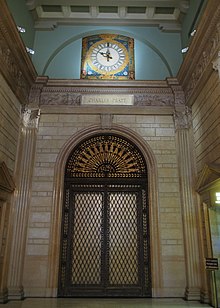Charles Pratt
Pratt was a pioneer of the U.S. petroleum industry, and he established his kerosene refinery Astral Oil Works in Brooklyn, New York.
He and his children built country estates in Glen Cove, New York, which became known as the Gold Coast in the 1920s on the North Shore of Long Island.
In 1916, Standard Oil had a steamship tanker, the first of its class, built at Newport News, Virginia, and it was named in honor of Pratt.
[citation needed] As a young man, Pratt joined a company in nearby Boston, Massachusetts, that specialized in paints and whale oil products.
[3] In the mid-1860s, Pratt met two young men, Charles Ellis and Rogers, in the area of the new oil fields of Venango County in western Pennsylvania.
Previously, Pratt had bought whale oil from Ellis in Fairhaven, Massachusetts, his and Rogers' coastal hometown.
They struck a deal and pre-sold the entire output of their small venture, Wamsutta Oil Refinery, to Pratt's company at a fixed price.
[citation needed] Ellis gave up, but in 1866, Rogers went to Pratt in New York City to say he would take personal responsibility for the entire debt.
[3] Pratt made Rogers foreman of his Brooklyn refinery, with a promise of a partnership if sales ran over $50,000 annually.
[citation needed] A short time later, Rockefeller approached Charles Pratt with plans for cooperation and consolidation.
Rogers formulated terms which guaranteed financial security and jobs for Pratt and him, which Rockefeller accepted.
[7] Around this time, the coopers' union opposed Pratt's efforts to cut back on certain manual operations, as they were the craftsmen who made the barrels that held the oil.
With Pratt's death in 1891, Rockefeller's position as the most powerful man in the oil industry, already well established, became unassailable.
Known as "Pratt Cemetery", behind ornate gates and up a winding drive stands a pink granite Romanesque mausoleum designed by William Tubby, as well as a crypt and a tower connected by a "bridge of sighs".
[citation needed][18] In March 1916, Newport News Shipbuilding and Dry Dock Company launched the S.S. Charles Pratt, a tanker of 8,807 tons with a capacity of 119,410 barrels (18,985 m3) of oil.
At the beginning of World War II, on December 21, 1940, the S.S. Charles Pratt was torpedoed and sunk by a German U-boat in the Atlantic Ocean 220 miles (350 km) off the coast of Africa while en route from Aruba to Freetown, Sierra Leone.


